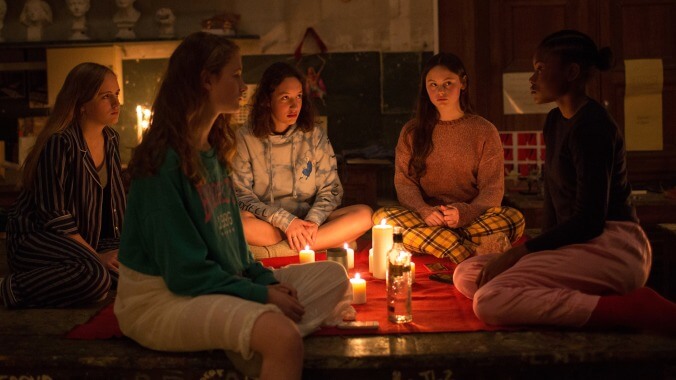Nocturama director Bertrand Bonello returns with the eerie and entrancing Zombi Child


Bertrand Bonello’s Zombi Child, an eerie film about teenagers and the spirit world that will leave some viewers puzzled, opens in Haiti in 1962. A man prepares a poisonous concoction of powdered pufferfish liver and seeds and pours it into a pair of shoes. The next day, Clairvius Narcisse (Mackenson Bijou), about 40, collapses in the street. He is buried by his family, only to be dug out of his grave later that night and taken to a sugarcane plantation. He has become a zombie (or zombi, in Bonello’s preferred Haitian spelling), drugged into a stupor, able only to work and moan. One can already discern an element of postcolonial metaphor to Clairvius’ story: There are many zombis in the sugarcane field, men with no memories of their pasts, ambling in a bluish darkness that recalls the day-for-night of much older movies.
Jump forward to France in the present. Mélissa (Wislanda Louimat), a Haitian orphan who lost both of her parents in the 2010 earthquake, is a student at an all-girls boarding school on the former grounds of an old abbey outside Paris. She has found a new friend in Fanny (Louise Labeque), a lovesick white classmate, and the two girls have bonded over their shared interest in horror movies, Urban Outfitters, and the Belgian-Congolese rapper Damso. While Mélissa is the central character, Fanny is the narrator of Zombi Child, in voice-overs that take the form of love letters to a long-distance boyfriend.
Though Bonello is a devoted student of the films of George A. Romero (whose Dawn Of The Dead was an acknowledged influence on his last film, the dark masterpiece Nocturama), there are no shambling, hungry zombies of the kind that Romero introduced into the mass imagination in Zombi Child. There are, however, possessions and ceremonies and supernatural entities, with the apparent goal of taking the zombi back to its Haitian origins and looking to Vodou, with its continua of life and death, for inspiration. (It’s worth mentioning here that Clairvius’ story is quasi-true, in the sense that there was a man named Clairvius Narcisse who claimed to have been zombified, buried alive, and made to work at a sugar plantation; it remains the basis for most attempts to scientifically explain the zombi.)
“Entrancing” is one way to describe Bonello’s films, so it makes sense that he would eventually tackle the subject of trances head on. Though he has directed movies since the late 1990s (including the likes of The Pornographer and On War, both about neurotic film directors, one of whom is even named “Bertrand”), his reputation as a seductive virtuoso rests on three features made in the 2010s: House Of Pleasures, an opium-haze group portrait of an upscale brothel at the end of the 19th century; Saint Laurent, an anti-biopic of the iconic French fashion designer; and the aforementioned Nocturama, about teenage terrorists who hide out in a department store in present-day Paris.
These are bravura works of dreamlike subjectivity and interiority in which the usual continuities of time, space, and music get bent at right angles. One recalls, among countless memorable sequences, the women of the Apollonide brothel slow-dancing to “Nights In White Satin,” with sound editing that alternately implies that the Moody Blues’ hit is anachronistically playing in the brothel parlor and only in their imaginations; Yves Saint-Laurent making eye contact with his eventual lover, Jacques de Bascher, in a disco, the traditional reverse angle replaced by a tracking shot across a packed dance floor; the crushing climax of Nocturama, which replays from different points of view in a time loop, the repetition signaled by John Barry’s addictive theme music from the early 1970s TV show The Persuaders! restarting on the soundtrack.
Ultimately, Bonello’s movies are about characters who have to make their own spaces in a world that doesn’t want them; they are lost in the music, caught in perfect moments, lounging in piles on furniture and grass. And there are similar sanctums to be found in Zombi Child, which cuts between Clairvius’ story in the 1960s and Mélissa’s experiences in the present. If there are obvious tinges of horror in the former, there are just as many (if not more) in the latter. The trappings of the boarding school, with its grand staircases, centuries-old cloisters, and self-serious teenage secrecy, are gothic. But Bonello nods just as much to American teen-anxiety horror. There is even an homage to Brian De Palma’s Carrie.
Yet despite the supernatural elements, one couldn’t honestly apply the label of a horror film to Zombi Child, which was made on a much more modest budget and scale than any of Bonello’s recent features. (One presumes that the failure of Nocturama, which was shut out of Cannes because of its subject matter and ended up flopping hard in France, had something to do with it.) At its core, this new film is a rumination on histories, fascinations past and present, and ironies, with two disparate sides. Ancestor worship may sound exotic to Mélissa’s classmates, but it also describes the mission of their boarding school, a real institution created by Napoleon where admission is still mostly limited to the daughters, granddaughters, and great-granddaughters of recipients of the Legion Of Honor.
While the boarding-school narrative is defined by layers of verbiage in the form of gossip, narration, classroom lectures, and student assignments (including a presentation on Rihanna), the Haitian scenes are largely wordless, and have a mysterious aura that is strongly reminiscent of the films of Claire Denis, no stranger to postcolonial body metaphors or enigmatic stories of dislocation. (The cinematographer is Yves Cape, who also lensed Denis’ White Material.)
Bonello knows his implications. Not for nothing, he opens the film with a quotation from a poem by the Haitian writer René Depestre that is later recited by Mélissa. In his take on that teen-movie staple, the oh so relevant introductory lecture, Mélissa and Fanny’s history teacher (played by the historian Patrick Boucheron in a cameo) speaks at length about the invention of French history in a classroom whose overwhelming visual impression is one of whiteness: the blank whiteboard, the walls, and, implicitly, Mélissa’s classmates. The result is sometimes too academic for its own good, and less transportive than the overlong and occasionally uneven Saint Laurent.
At the same time, it’s hard to deny Zombi Child’s suggestive power: the curious refractions; the fantasies; the parallels of Vodou and the candlelit rituals of teen girlhood, putting on make-up and lip-synching to music as though one were channeling something from the pop beyond. Possession mingles with teenage obsession, mysticism with longing, unseen sugar barons with Baron Samedi, the rum-loving Vodou loa of magic and death. For Bonello, whose previous films have emphasized emotional continuity over conventions of chronology and realism, it all seems to be part of the same continuum, suggesting a deeper, contradictory myth.